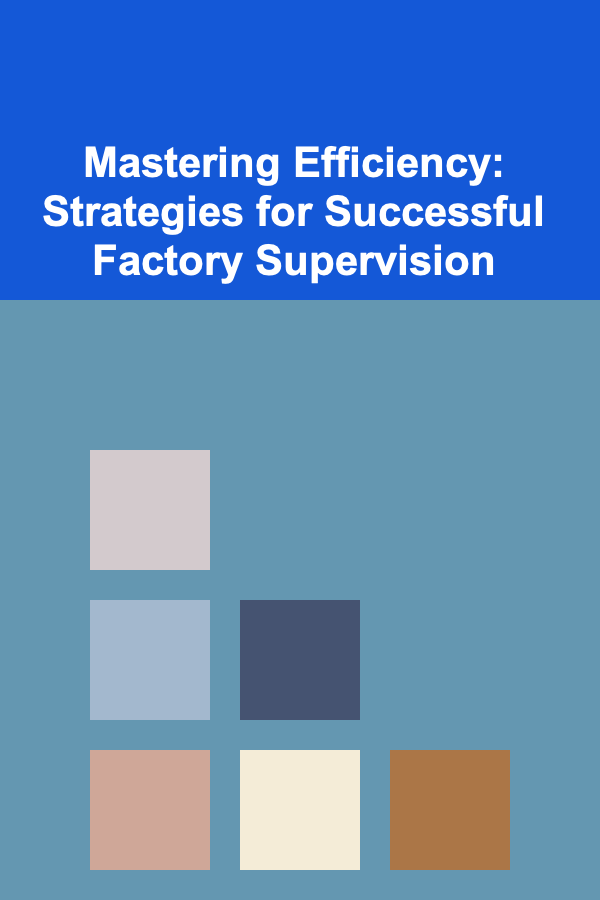
Creative Director's Handbook: Strategies for Driving Creativity and Achieving Impact
ebook include PDF & Audio bundle (Micro Guide)
$12.99$10.99
Limited Time Offer! Order within the next:

The role of a Creative Director is multifaceted, blending artistry with leadership, strategy with innovation. A Creative Director doesn't just generate ideas but drives creative vision, builds and leads teams, and ensures that the creative output aligns with broader business goals. Success in this role is not just about the ability to design but about orchestrating the creative process to deliver impact, inspire innovation, and maintain a consistent vision.
In this actionable guide, we'll explore the key strategies and best practices that will help you navigate the challenges of a Creative Director's role and successfully drive creativity while achieving meaningful outcomes for your brand or business.
Establish a Strong Creative Vision
A successful Creative Director begins with a clear and strong creative vision. This vision should align with the company's overarching goals, ensuring that all creative work reflects the brand's identity and future direction. The ability to communicate this vision across all levels of the organization and to your creative team is essential for achieving consistency and success.
Actionable Steps:
- Understand the Brand's Core: Take time to immerse yourself in the brand's history, mission, values, and target audience. Understanding the brand's core will give you the foundation for creating a vision that resonates authentically with your audience.
- Define Key Objectives: Clarify what you want your creative output to achieve. Are you focusing on brand awareness, customer engagement, product launches, or innovation? Setting specific, measurable objectives will allow you to align your team's efforts with the brand's goals.
- Craft a Clear and Compelling Narrative: A compelling creative vision is often told through a story. Develop a narrative that inspires your team, defines the brand's essence, and guides decision-making. This narrative should be flexible enough to evolve while remaining consistent with the brand's identity.
Foster a Collaborative and Innovative Environment
Creativity thrives in environments where collaboration and innovation are encouraged. As a Creative Director, you must foster a culture where new ideas are embraced, risk-taking is supported, and feedback is constructive. You need to build an environment that empowers your team to think outside the box, experiment, and push boundaries.
Actionable Steps:
- Build a Diverse and Talented Team: Diversity in skills, backgrounds, and perspectives leads to richer, more innovative creative outputs. Look for team members who complement your strengths and who bring different skills to the table.
- Encourage Open Communication: Create an environment where your team feels comfortable sharing ideas, providing feedback, and voicing concerns. Regular team meetings, brainstorming sessions, and one-on-one check-ins can foster open communication.
- Promote Cross-Department Collaboration: Collaboration shouldn't be confined to the creative team. Work closely with marketing, product, and other departments to ensure that the creative vision supports and enhances broader business strategies.
Lead with Empathy and Clarity
Effective leadership goes beyond providing direction and oversight; it involves motivating, mentoring, and guiding your team through both successes and challenges. As a Creative Director, your leadership style will significantly influence the team's morale, creativity, and output. Balancing empathy with clarity is key to maintaining a high-performing team.
Actionable Steps:
- Listen Actively: Understand the needs, challenges, and aspirations of your team members. Actively listening builds trust and shows that you value their contributions.
- Provide Clear Guidance: While creative freedom is important, your team needs a clear sense of direction. Communicate the "why" behind every project, from overarching goals to specific design choices, so that team members feel confident in their decisions.
- Offer Constructive Feedback: Feedback should be specific, actionable, and designed to help team members grow. Provide constructive criticism that focuses on the work, not the individual, and offer solutions or alternatives where necessary.
- Recognize Effort and Achievement: Regularly acknowledge both individual and team successes. Recognition motivates the team and reinforces a positive work culture.
Balance Creativity with Practical Constraints
While creativity is the heart of the Creative Director's role, practicality must also be at the forefront. Creative ideas must be executed within the parameters of budgets, timelines, and available resources. A good Creative Director is not just a dreamer but someone who can turn ideas into actionable plans and ensure their feasibility.
Actionable Steps:
- Set Realistic Expectations: Understand the constraints you're working within, whether it's budget, timelines, or resources. Being realistic in the planning stage ensures that ideas are not only creative but also achievable.
- Use a Structured Creative Process: Implementing a clear and structured process---from concept to execution---helps keep projects on track. Use project management tools to ensure that deadlines are met and tasks are prioritized.
- Optimize Resources: Make the best use of available resources. Whether it's leveraging existing tools, utilizing in-house talent, or streamlining workflows, ensure that creativity doesn't get lost in the logistics.
Maintain Consistency Across All Touchpoints
Consistency is one of the most vital aspects of effective branding and design. As the Creative Director, you are the custodian of the brand's voice, look, and feel across every platform and channel. Whether it's digital, print, or social media, your job is to ensure that the brand remains consistent in its messaging and aesthetics.
Actionable Steps:
- Create Brand Guidelines: Develop and enforce brand guidelines that clearly outline the visual identity, tone of voice, typography, color schemes, and other key brand elements. These guidelines should be referenced across all projects to maintain a unified brand presence.
- Regularly Audit Creative Work: Periodically review creative work to ensure it adheres to the brand's standards. Regular audits help catch inconsistencies early and ensure that the brand's image remains strong and cohesive.
- Adapt Without Compromising Identity: While consistency is key, the brand must remain flexible and adaptable to changing market conditions. Ensure that the brand evolves in a way that feels authentic, rather than rigid or outdated.
Adapt to Emerging Trends and Technology
The creative landscape is constantly evolving, with new trends, tools, and technologies emerging all the time. As a Creative Director, it's essential to stay ahead of these changes, not just to remain competitive but also to inspire innovation within your team.
Actionable Steps:
- Stay Informed About Industry Trends: Subscribe to industry publications, attend creative conferences, and engage with online communities. Keeping up with the latest design trends, tools, and platforms will help you spot opportunities for innovation.
- Experiment with New Technologies: Encourage your team to experiment with new design tools, platforms, or creative techniques. Whether it's new digital design software, virtual reality, or AI-driven creative tools, innovation can provide a competitive edge.
- Integrate Emerging Trends Thoughtfully: While it's tempting to chase after every new trend, ensure that any trend you integrate aligns with your brand and vision. Don't jump on a bandwagon just for the sake of it---every new direction should feel authentic to the brand.
Measure the Impact of Creative Work
Creative work isn't just about producing aesthetically pleasing visuals or innovative campaigns; it's about driving tangible results. A successful Creative Director understands the importance of measuring the effectiveness of creative output to ensure that it meets the strategic goals of the business.
Actionable Steps:
- Define Key Performance Indicators (KPIs): Establish KPIs to measure the impact of your creative work. These could include metrics like customer engagement, brand awareness, sales, or social media performance.
- Collect and Analyze Feedback: Gather feedback from both internal stakeholders and external audiences to evaluate the success of creative campaigns. Use data to identify what worked and what could be improved.
- Iterate Based on Results: Use insights from the feedback and performance metrics to inform future creative work. If something isn't working, be prepared to pivot and adjust your approach.
Nurture Personal and Team Growth
A successful Creative Director doesn't just focus on delivering exceptional work today but also on fostering an environment where both their team and themselves can grow. Continuously developing your skills, learning from experience, and encouraging your team's professional growth will ensure sustained success.
Actionable Steps:
- Invest in Personal Development: Never stop learning. Attend workshops, take courses, and seek mentorship to refine your skills. Staying sharp is crucial to maintaining your leadership role in an ever-evolving industry.
- Provide Opportunities for Growth: Give your team members opportunities to expand their skills and take on new challenges. Offering growth paths, whether through new responsibilities, training, or exposure to different types of work, fosters a culture of improvement and retention.
- Encourage a Growth Mindset: Cultivate a growth mindset within your team. Encourage them to embrace challenges, learn from failures, and continuously evolve as creative professionals.
Conclusion
Becoming a successful Creative Director is about more than just generating ideas; it's about leading with vision, building a strong and motivated team, adapting to the changing creative landscape, and aligning creative efforts with business objectives. By establishing a clear creative vision, fostering collaboration, balancing creativity with practical constraints, and measuring the impact of your work, you can achieve significant results and drive meaningful success for your brand.
Ultimately, creativity is not just about the final product but the process---the people you work with, the environment you cultivate, and the results you achieve. With the right strategies in place, you can inspire, innovate, and lead your team toward a bright, creative future.
Reading More From Our Other Websites
- [Home Security 101] How to Implement Effective Burglary Deterrents to Keep Intruders Away
- [Metal Stamping Tip 101] How Material Hardness Impacts Tool Life in Metal Stamping Operations
- [Home Budget Decorating 101] How to Add Luxury to Your Home with DIY Decor Projects
- [Organization Tip 101] Common Mistakes to Avoid When Setting Up Drip Irrigation
- [Home Party Planning 101] How to Plan a Memorable Holiday Party for Family and Friends
- [Organization Tip 101] How to Organize a Scrapbook for Family Memories
- [Rock Climbing Tip 101] Best Climbing Footwear for Overhanging Routes: Finding the Perfect Fit
- [Weaving Tip 101] A Stitch in Time: Exploring the History Behind Classic Weaving Patterns
- [Organization Tip 101] How to Streamline Your Grocery Shopping Process
- [Home Security 101] How to Keep Your Home Secure by Regularly Updating Smart Device Firmware

Customer Journey Mapping: A Comprehensive Guide for Customer Insights Analysts
Read More
Mastering Efficiency: Strategies for Successful Factory Supervision
Read More
Top Tips for Buying Used Electronics and Getting the Best Deals
Read More
How To Understand the Role of Mistrust in Government
Read More
10 Tips for Optimizing Your Recovery with a Weightlifting To-Do List
Read More
How to Track Your Geocaching Progress and Stats
Read MoreOther Products

Customer Journey Mapping: A Comprehensive Guide for Customer Insights Analysts
Read More
Mastering Efficiency: Strategies for Successful Factory Supervision
Read More
Top Tips for Buying Used Electronics and Getting the Best Deals
Read More
How To Understand the Role of Mistrust in Government
Read More
10 Tips for Optimizing Your Recovery with a Weightlifting To-Do List
Read More